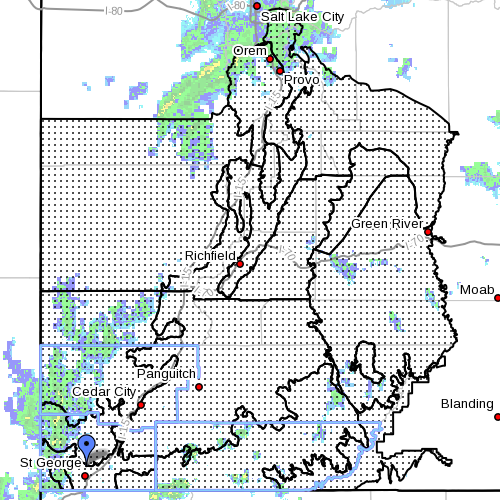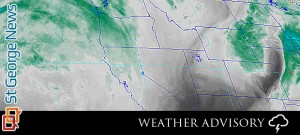
SOUTHERN UTAH – The National Weather Service has issued a “Flash Flood Watch” for portions of central, northern, southern and southwest Utah in effect from noon through midnight today. A “Flash Flood Watch” means that conditions may develop that lead to flash flooding.
Conditions – A low pressure system moving north into the very moist air mass across Utah this afternoon will spawn widespread shower and thunderstorm activity across all but the northwest corner of the state through this evening.
Very heavy rainfall is expected with a number of the showers and thunderstorms; the heaviest rains are forecast along and to the east of the Interstate 15 corridor.
The southwest and south-central portions of Utah will be the first to see heavy rainfall this afternoon. This threat will diminish after early this evening.
Areas to the north and east will see the best threat for heavy rainfall later in the afternoon and on through this evening.

Affected areas – Castle Country, central mountains, San Rafael swell, Sanpete/Sevier valleys, Wasatch Plateau/Book Cliffs, and book cliffs; the southern Wasatch front and Wasatch mountains south of Interstate 80; Glen Canyon Recreation Area / Lake Powell, south central Utah, southwest Utah and Utah’s Dixie and Zion National Park.
At risk – All areas that are typically prone to flash flooding such as small creeks and streams in steep terrain, slot canyons and normally-dry washes will all be at risk for flash flooding through this evening.
Precautionary and preparedness actions
The National Oceanic and Atmospheric Association and the National Weather Service offer safety rules for flash flooding:
- Conditions may develop that lead to flash flooding. Flash flooding is a very dangerous situation.
- Flash flood waves, moving at incredible speeds, can roll boulders, tear out trees, destroy buildings and bridges, and scour out new channels. Killing walls of water can reach heights of 10 to 20 feet. You will not always have warning that these deadly, sudden floods are coming. When a flash flood warning is issued for your area or the moment you first realize that a flash flood is imminent, act quickly to save yourself. You may have only seconds.
- Most flood deaths occur in automobiles. Do not drive your vehicle into areas where the water covers the roadway. Floodwaters are usually deeper than they appear. The roadbed may not be intact under the water. Just one foot of flowing water is powerful enough to sweep vehicles off the road. If the vehicle stalls, abandon it immediately and seek higher ground. Rapidly rising water may engulf the vehicle and its occupants and sweep them away. Case in point: In July 2013 a tour bus in Arizona tipped over and got swept nearly one-half mile down an otherwise dry wash.
- Do not hike rivers and especially slot canyons while flash flood warnings are in place, do not hike alone and tell someone where you are going.
Turn around, don’t drown.
Related posts – Storm, flash flooding
- I can’t believe I survived; video of flash flood crashing down on canyoneers
- Flood victims blame city for neglect
- Charges filed in tour bus accident
- Tour bus gets swept down wash after heavy rains
- UPDATED: Summer storm floods Coral Canyon homes; STGnews Videocast
- Flash flooding meets River Road near Southern Parkway; Videocast, STGnews photo gallery
Email: [email protected]
Twitter: @JoyceKuzmanic
Copyright St. George News, SaintGeorgeUtah.com LLC, 2013, all rights reserved.
